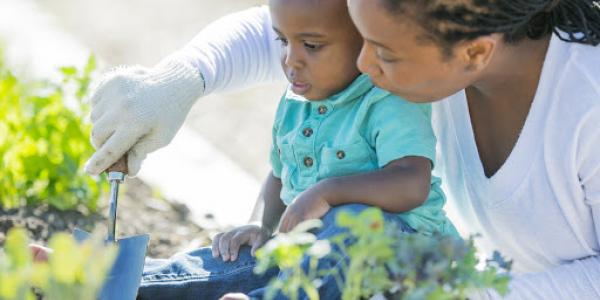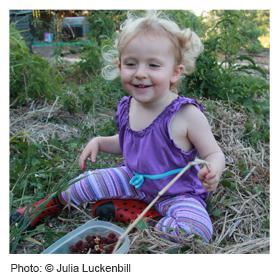7 Tips for Vegetable Gardening With Your Toddler

You are here
by Julia Luckenbill
 It’s gardening season, and here in California our vegetable gardens are overflowing with tomatoes, zucchini, and beans. Well, some of our gardens are. Those of us who have small toddler helpers may not have the loveliest veggies to show for it, but we have learned some important lessons along the way. Here are some tips:
It’s gardening season, and here in California our vegetable gardens are overflowing with tomatoes, zucchini, and beans. Well, some of our gardens are. Those of us who have small toddler helpers may not have the loveliest veggies to show for it, but we have learned some important lessons along the way. Here are some tips:
1. Know your stuff. Be smart about gardening before your small helper joins you. Do some research to find the best times to plant various crops in your area. Prepare your soil so it’s soft enough for your toddler’s shovel and spade. Try to find a space that is mostly sunny and not too shady. Add compost generously.
2. Relax. Toddlers will pick the first green tomato before it ripens. They will put your pepper starts into the ground upside down, roots up, breaking off stems. They will plant 32 bean seeds in one hole and then forget to put any in the second hole. They will cry when the compost needs to go on plants because they were using it for dirt castles. Toddlers are too young to see the big picture.
3. Keep your goals simple. This year we have late tomatoes and no zucchini. Why? We started planting late. After all, we have a toddler! We do have many green beans, as these are planted later in the summer, and in a few weeks the tardy tomatoes will fruit. Your garden doesn’t need to be perfect. What is important is allowing your child access to growing a few crops and tasting what he has planted.
4. Make your planting rows obvious. We don’t have wooden edges around our vegetable beds in our gardens because it’s hard to keep the soil fertile in a contained box. Other gardeners with young children often raise their beds in boxes to make a visual “keep out,” Since we avoided this, our vegetable beds in the garden must stand out (for feet). We used bark to accomplish this, as it made the walking paths a different color and texture). This way we could coach our toddler to stay on the bark and off of the baby plants. We also used tomato cages to keep our toddler off of less obvious young plants.
5. Have a “can-do” garden. Our toddler can dig, fill pots and bags, pull off ripe tomatoes and peppers, carry a watering can, hold a hose, taste the produce, and push a cart. When we go to the garden with her, she likes to help for a little while. She enjoys it long enough to harvest tomatoes but not long enough to weed. When she wants to help, we try to assign her an important job, but then we let her play with her plastic tractor or feed the chickens when gardening is no longer fun. That way the message in the garden is “Yes.”
6. Eat what you grow. Children imitate what they see. If you want your toddler to try a radish, try one too. If you want your toddler to taste Swiss chard, taste it too. There are many fun recipes to try with toddlers (like vegetable soup or tomato sauce), but it’s wise to plant some crops that can be eaten right away (says the mother of the toddler who repeatedly tasted our raw potatoes).
7. Have fun. It’s okay for your toddler to hoard the bean seeds, hide under the sunflowers, and pretend the peppers are tongues. Gardening doesn’t need to only involve watering, weeding, planting, and harvesting. As with any other process, toddlers think outside the box. Soon enough they will be planting in rows. This is the time to have a jumbled and joyful garden.
Julia Luckenbill, M.A. is a Child Development Demonstration Lecturer at the Center for Child and Family Studies Laboratory School at the University of California, Davis. Her interests include emergent curriculum, farming with toddlers, photography, and exploring the world with her daughter.